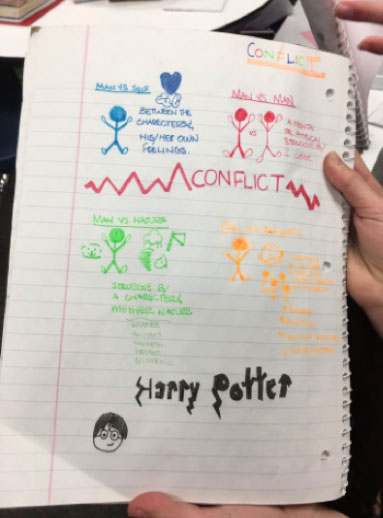April 12, 2018
Literacy is a foundational part of our personal and professional lives. As educators, we have internalized much of the reading and writing process. But these tasks can often feel challenging or nebulous to our students. Why is this the case?
Unlike solving a math problem, we can’t always break down reading and writing into clear steps. As a result, teachers may struggle to find strategies to help students improve their literacy skills. So, they often end up assigning reading and writing as homework instead of teaching reading and writing skills and strategies in the classroom.
Learning to understand a poem or structure an argumentative essay is a challenge. That said, there are principles that teachers can apply to their instruction to maximize effectiveness.
The ideas that follow are not a quick fix. They are a menu of options that teachers can include, when appropriate, to make reading and writing lessons more impactful for students.

4 strategies for effective reading instruction
Because literacy is the basis for all learning, effective reading instruction is essential for student success in all subject areas. In order to support students’ development of strong reading skills, there are several strategies that teachers can use to engage students and promote deeper comprehension.
#1: Think aloud
One of the most effective reading strategies is to think aloud. Teachers often forget everything that goes into understanding a text. Developing readers often don’t know the mental work required to turn the words on the page into meaning. This creates an opportunity for teachers to model their thinking process for the class in a formal “Think Aloud.” This is when the teacher reads a text aloud, pausing to explain her thoughts. It might sound something like this:
“Here, at the beginning of the novel, I notice that the main character is reflecting on her experience from high school, even though we’re told that she is now thirty years old. This makes me wonder why the author has chosen to have the older version of the narrator tell the story—and why these memories from her teenage years are so important to her at this point in her life.”
Thinking aloud requires practice, and it’s alright if it doesn’t succeed the first time. In fact, it can be good for students to see teachers struggle occasionally. This shows students that everyone can struggle with comprehension and may need to go back and reread portions of a text in order to understand specific details.
#2: Set a purpose for reading
This point refers to teaching whole class texts, whether that is an article, a novel, a poem, a play, or even a digital text. Students are more engaged in their reading if the teacher sets a purpose for reading. This can include a specific question to answer or a prompt to respond to. An alternative is to ask students to make a mark where something in the text is surprising or interesting, and to be ready to explain their choice in more detail when called upon.
The purpose for reading does not need to be complex, only focused.
#3: Write to learn
Reading and writing are recursive processes, which is why writing to learn is not only an effective writing strategy but is beneficial for reading comprehension, too.
In fact, reading and writing lead into and complement each other. Often, students will process a text better if they write about the text after reading it. One way to do this is with “quick write” prompts. This is when students are given a short period of time (two minutes, for example) to respond to a specific quote or question.
Another option is to ask students to explain how some part of the text relates to or differs from their lives, what surprised them in a text, what questions or topics they’d like to learn more about after reading the text, etc.
Creating confident readers
Discover tools from Renaissance to help all learners become skilled readers.
#4: Use visuals
Sometimes, visuals make all the difference. This is why things like sketchnoting can support readers by providing an outlet to create meaning through different forms of note-taking, including labels, structure, icons, and various pictures to help them process information.
Sketchnoting can help students capture key information from a text, remember it, and share it with others in a way that makes sense to them. It is a form of mnemonics, meaning it connects information with images, making it easier to remember what we’ve read or learned.

4 strategies for effective writing instruction
Similar to reading instruction, effective writing instruction provides students with a well-rounded education, and the right strategies can set students up with the communication skills and problem-solving abilities they need for success.
#1: Teaching pre-writing
Have you heard of “blank page syndrome?” This is when students stare at a blank computer screen or piece of paper. The cursor blinks, the pen twiddles, without a word appearing on the page.
Writing with fluency and volume is not natural for most people. Teaching pre-writing strategies helps students to get started so they can organize their thoughts and build momentum. Some examples of prewriting strategies include:
- Listing questions the student has about an expository topic.
- Listing opinions from many perspectives for an argumentative piece.
- Using a plot diagram to outline a narrative.
#2: Sentence combining
Grammar instruction often overwhelms teachers just as much as grammar rules overwhelm students. One simple entry point is teaching students explicit techniques for combining sentences. Teachers can present students with sophisticated sentence structures, which lead to more sophisticated thoughts. The teacher can include terms and rules into these lessons because there is context for them.
#3: Studying mentor texts
Students learn to write by watching good writers and—in some sense—doing what they do. For example, are your students interested in writing editorials to share their views on an issue? Then the whole class can study editorials from popular news sites.
In the follow-up, students can then read a variety of editorials on their own. They can make lists of the structural and stylistic techniques that writers of the genre use. Furthermore, teachers can ask students to copy the style of good sentences from these mentor texts. This leads into writing full pieces in the style of mentor texts that the class has studied.
#4: Shared writing
Shared writing is a highly effective instructional strategy that can be used to teach writing skills to students of all ages and skill levels. This approach involves the teacher and students collaborating to create a piece of writing, such as a story or an essay.
As the teacher models the writing process, students are able to observe and participate in the process of planning, drafting, revising, and editing a piece of writing. By working together with instructors and peers, students are able to learn from one another and receive immediate feedback from the teacher.
This collaborative approach helps to build confidence and motivation in students while also improving their writing skills. Shared writing also allows for differentiated instruction, as the teacher can adjust the level of support based on each student’s or each group’s needs.

Renaissance: Providing solutions for reading and writing success
Effective reading and writing instruction can be challenging to plan and deliver. With so many needs in a single classroom, a teacher needs a whole toolkit of strategies. There are no magic tricks for improving literacy, but there are guiding principles.
Renaissance offers teachers a variety of resources to support effective reading and writing instruction. Our solutions include:
- FastBridge and Star Assessments, for reliable insights into students’ current reading skills and instructional needs.
- Accelerated Reader, to motivate and monitor students’ independent reading practice and spark a love of reading.
- The myON digital platform, which provides 24/7 access to thousands of books and news articles—along with embedded reading and writing tools.
- Freckle for ELA, for differentiated practice on essential reading and writing skills across K–12.
Whether you’re an instructor looking for greater insights into your students’ needs and abilities, or you’re looking for strategies to help improve their reading and writing capabilities, Renaissance’s solutions provide instructors with the tools and resources they need to help their students develop the skills necessary for academic success.
Learn more
Connect with an expert today to learn more about these and other Renaissance solutions.

